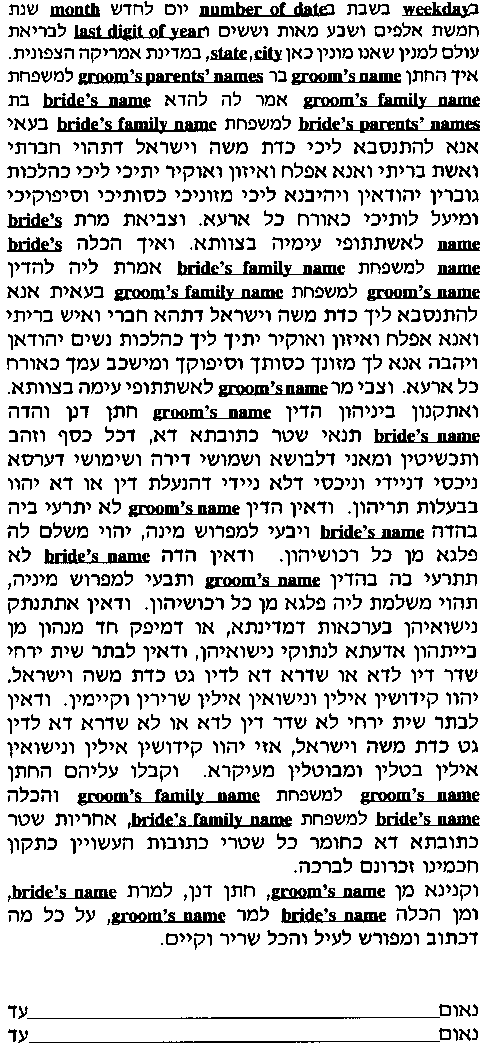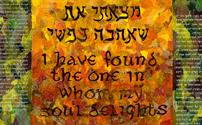- Traditional Texts
- Traditional Egalitarian Texts
- Modern Texts
- Covenant Texts
- Interfaith Texts
- Same Gender Texts
- Secular Texts
Same Gender Texts
Same Gender Egalitarian Aramaic
The Egalitarian Aramaic ketubah text was written in Aramaic by Dr. Aryeh Cohen, Talmudic Professor at the University of Judaism. This text draws upon several formulations found in Palestinian ketubahs from medieval times. It also includes an antenuptial agreement written by the Rabbinical Assembly in 1968. Cohen authored one new element in his ketubah text, which is based upon civil laws in the U.S.
The Egalitarian Aramaic ketubah text creates an egalitarian marriage that can also be considered traditional and halachic. It is a completely bilateral contract. This text is based upon several formulations found in Palestinian ketubot and researched and described by Moredechai Friedman in Jewish Marriage in Palestine (JTS,1980). It begins with the formulation, “I wish to be married to you.” The verb here is passive, unlike the verb in “become my wife”. As Friedman says: “[This] usage in which the groom declares (his desire) to “be married” to the bride, rather than to “marry” her, is curious, since the husband’s active role in contracting the marriage is taken for granted in our sources and is normally understood as being reflected in the marriage formula as well. One is tempted to see in this usage an expression of the equality of the partners in marriage.” Cohen adds, “especially if one (or two) double the formula”, as this text does. The next formulation is “so that you should be my companion and woman/ man of covenant”. This is paraphrased from Malachi 2:14 and recalls the covenantal relationship between God and Israel. Then, the bride and groom agree “to enter into a partnership” with each other. Partnership, or shutafut, describes a relationship between equal partners who can each withdraw from the partnership at will (Friedman). Cohen adds one new element to his text in the statement that all the property, “that either of them brings with them, shall be in possession of both.” This reflects the very notion of an egalitarian relationship. Cohen describes this statement: “some halacha becomes accepted because it makes sense.” In other words, as a rabbinical and talmudic scholar, he is joining the ever-evolving process of creating halacha.
The Egalitarian Aramaic ketubah requires a truly egalitarian divorce. The party initiating the divorce must pay the other half their property, a statement which reminds the marrying couple that marriage and divorce entail financial consequences. This provision is based upon a number of different mutual divorce stipulations in medieval Palestinian ketubot found in a Geniza in Cairo. Both bride and groom can send a Get. Cohen includes an antenuptial agreement based upon one written by the Rabbinical Assembly in 1968. It states that if no Get is sent within six months of their marriage being sundered by the courts of the State, or within six months of one of them leaving their home with the intent of sundering their marriage, then this betrothal and marriage will be null and void from the start. Cohen makes this antenuptial agreement mutual, whereas the original RA agreement was written from the groom to the bride.
English:
Text by Aryeh Cohen
We witness that on the day of the week, the day of the month of , in the year , corresponding to the day of , , here in , the groom/bride, , son/daughter of , said to the bride/groom, , daughter/son of : I wish to be married to you according to the laws/religion of Moses and Israel, so that you should be my friend and woman/man of covenant and I will work and support and honor you as is the way of Jewish women/men, and I will give you your food, clothing and desires/wants/needs and have conjugal relations with you. And agreed to enter into a partnership with her/him. And that said to , I wish to be married to you according to the laws/religion of Moses and Israel, so that you should be my friend and woman/man of covenant and I will work and support and honor you as is the way of Jewish women/men, and I will give you your food, clothing and desires/wants/needs and have conjugal relations with you. And agreed to enter into a partnership with her/him. And and fixed between them the conditions of this ketubah, that all silver, gold, jewelry, and articles of clothing, furniture and bedding, moveable and real estate that either of them brings with them, shall be in possession of both. And if would no longer desire this woman/man and wish to separate from her/him, she/he will pay her/him half of all their property. And if would no longer desire this woman/man and wish to separate from her/him, she/he will pay her/him half of all their property. And if their marriage is sundered by the courts of the State, or if one of them leaves their home with the intent of sundering their marriage, and if after six months sends to , or sends to a get according to the laws of Moses and Israel, then this betrothal and marriage shall be right and good. But if after six months, hasn’t sent , nor has sent a get according to the laws of Moses and Israel, then this betrothal and marriage will be null and void from the start. And and accepted upon themselves legal responsibility for this ketubah as weighty as all ketubah contracts which are made according to the ordinances of our Sages of blessed memory.
Hebrew:
The B’rit Ahuvim/Ahuvot ~ Lovers’ Covenant was written by Rachel Adler in Modern Hebrew for her own wedding and published and thoroughly explained in her book, Engendering Judaism (Beacon Press, 1998). Adler is a Jewish feminist theology professor at Hebrew Union College in Los Angeles, California. This text, which she describes as “a new legal model for right relations between husbands and wives”, draws upon the halakha of Jewish partnership law for creating a Jewish marriage. In this it is revolutionary.
The B’rit Ahuvim/Ahuvot ~ Lovers’ Covenant text creates an egalitarian partnership for the marrying couple which is formed by mutual agreement. Adler includes grammatical provisions to allow her text to be easily used for same-gender marriages. Partnership law is the basis for this text and the marriage it creates. The marriage created is not a halachic Jewish marriage but rather a halchic Jewish partnership. Adler describes the rituals that should establish this marriage (see pp. 195-8). The most innovative ritual is an ancient version of kinyan. In this, the partners acquire the partnership by placing symbols of pooled resources (often including wedding rings) into a bag, lifting it together, and reciting a blessing. This form of kinyan was used in ancient times exclusively for creating partnerships under Jewish law. While Adler encourages couples to write their own, several intentions for the marriage are included in the text. The partners agree to pool their resources and to make joint decisions about their distribution; to base their marriage upon monogamy, tikkun olam and other Jewish communal responsibilities; to care and provide for each other and for any children; and to help each other at the time of dying. The B’rit Ahuvim connects the marrying couple to God, Israel and Jewish history by quoting several definitions and instances of covenant found throughout theTanakh.
The B’rit Ahuvim/Ahuvot ~ Lovers’ Covenant can be dissolved as a partnership would be dissolved. Either partner may initiate a divorce. The divorce should be conducted by a Beit Din (a court of three learned Jews). At the dissolution proceeding, the court should draw up a document in Hebrew (and translate it into the vernacular) that attests to the termination of the covenant, the distribution of property, and any continuing obligations. This document should be signed by two witnesses. Adler suggests that the divorce be held in public rather than in a Rabbi’s study with only the court and witnesses present. Religious community, friends and family should be present to comfort and console the two partners and to acknowledge that a covenant has failed.
English:
On the day of the week, the day of the month of , in the year , corresponding to the day of , , here in , the bride/groom/partner/spouse/lover , , son/daughter of , and the bride/groom/partner/spouse/lover, , daughter/son of confirm in the presence of witnesses a lovers’ covenant between them and declare a partnership to establish a household among the people of Israel.
This agreement into which and are entering is a holy convenant like the ancient covenants of our people, made in faithfulness and peace to stand forever. It is a covenant of protection and hope like the covenant God swore to Noah and his descendants, saying,
When the bow is in the clouds, I will see it and remember the everlasting covenant between God and all living creatures, all flesh that is on earth. That,” God said to Noah, “shall be the sign of the covenant that I have established between me and all flesh.
It is a covenant of distinction, like the covenant God made with Israel, saying You shall be my people, and I shall be your God.
It is a covenant of devotion, joining hearts like the covenant David and Jonathan made, as it is said:
And Jonathan’s soul was bound up with the soul of David. Jonathan made a covenant with David because he loved him as himself.
It is a covenant of mutual lovingkindness like the wedding covenant between God and Zion, as it is said,
I will espouse you forever. I will espouse you with righteousness and justice and lovingkindness and compassion. I will espouse you in faithfulness and you shall know God .
The following are the provisions of the lovers’ covenant into which bride/groom/spouse and bride/groom/spouse now enter:
and declare that they have chosen each other as companions, as our rabbis teach:
Get yourself a companion. This teaches that a person should get a companion, to eat with, drink with, to study… with, to sleep with, to confide all one’s secrets, secrets of Torah and secrets of worldly things.
and declare that they are setting themselves apart for each other and will take no other lover. and hereby assume all the rights and obligations that apply to family members: to attend, care, and provide for one another
- and for any children with which they may be blessed. (optional)
- and for , child/children of . (optional)
and commit themselves to a life of kindness and righteousness as a Jewish family and to work together toward the communal task of mending the world. and pledge that one will help the other at the time of dying, by carrying out the last rational requests of the dying partner, protecting each other from indignity or abandonment and by tender, faithful presence with the beloved until the end, fulfilling what has been written:
“Set me as a seal upon your heart, as a seal upon your arm, for love is stronger than death.”
To this covenant we affix our signatures:
Hebrew:
Covenant
We witness that on the ___ day of the week, the _________ day of the month of __________, in the year ________, corresponding to the ______ day of ______, _______, here in ______________: , the Bride, ___________, daughter of ____ and _____, and the Groom, ____________, son of _____ and _____, did stand together under the chuppah, in the presence of family and friends, and enter into the covenant of marriage according to the laws of Moses and Israel, and do hereby stand in a holy partnership, together with God, for the purposes of establishing together a Jewish home and family. The bride and groom did say, one to the other: “I take you this day as my husband, “I take you this day as my wife,” as is understood in the custom of Israel, and do promise to equitably provide for the well-being of our home, and for the care, raising, and teaching of our children. I promise to exercise patience, to seek to understand you, to be kind, and to be loving. I agree that we enter into this marriage as helpers that are equal to each other, and that we shall always work to sustain the sanctity of our covenant. I promise to establish with you a house of Israel that is based on the teachings and principles of Torah, and on the oneness and centrality of God. I promise to remain faithful to this covenant, in body and in spirit, through passion and mundanity, through abundance and scarcity, through health and illness, and through joy and sorrow.” And they did both accept this covenant, each from the other.
Hebrew:
Reform A Gender Neutral
The Reform A ketubah text is a modern creation written in Modern Hebrew. It is an egalitarian text which forgoes preparations for disaster in order to focus on the type of partnership that is being created. The relationship is described as one of mutual support, respect, and devotion. Several intentions are included: sharing and being open with each other; cherishing each other’s uniqueness; comforting each other in times of sorrow and joy; and challenging each other to realize his/her full potential. The marriage envisioned creates commitment by developing the fulfillment and satisfaction of the partners. This text connects the marrying couple to Israel and Jewish history in several ways. First, the bride and groom consecrate themselves to each other “according to the tradition of Moses and the Jewish people”. This reflects the formula that begins the traditional texts except that it deletes the word “laws” [of Moses] Second, the couple pledges to celebrate Jewish holidays and life cycle events. Third, they pledge to join their home “ever more closely to the community of Israel.” This ketubah text does not make provisions for divorce. Divorce is left to the civil courts.
English:
We witness that on the day of the week, the day of the month of , in the year , corresponding to the day of , , here in :
, son/daughter of , says to , daughter/son of , “With this ring you are consecrated unto me as my partner according to the tradition of the Jewish community. I shall treasure you, nourish you, support you, and respect you as Jewish men/women/spouses and men/women/spouses have devoted themselves to their lovers with integrity.” , son/daughter of , says to , daughter/son of , “With this ring you are consecrated unto me as my partner according to the tradition of the Jewish community. I shall treasure you, nourish you, support you, and respect you as Jewish men/women/spouses and men/women/spouses have devoted themselves to their lovers with integrity.” We promise to try to be ever open to one another while cherishing each other’s uniqueness; to comfort and challenge each other through life’s sorrow and joy; to share our intuition and insight with one another; and above all, to do everything within our power to permit each of us to become the persons we are yet to be. We also pledge to establish a home open to the spiritual potential in all life; a home wherein the flow of the seasons and the passages of life are celebrated through the symbols of Jewish heritage; a home filled with reverence for learning, loving, and generosity; a home wherein ancient melody, candles, and wine sanctify the table; a home joined ever more closely to the community of Israel. This marriage has been authorized also by the civil authorities of New York. It is valid and binding.
Hebrew:
Same Gender - Wedding Blessing
We witness that on the day of the week, on the day of the month of , in the year , corresponding to the day of , , here in , , United States of America, the bride/groom, , daughter/son of , and the groom/bride, , son/daughter of , entered into this sacred marriage covenant. Standing together hand in hand they said to each other: “Now we will feel no rain, for each of us will be shelter for the other. Now we will feel no cold, for each of us will be warmth to the other. Now there will be no loneliness, for each of us will be companion to the other. Now we are two persons, but there is only one life before us. May beauty surround us in the journey ahead and through all the years. May happiness be our companion and our days together be good and long upon the earth. We promise to treat ourselves and each other with respect, to remind ourselves often of what brought us together, and to give the highest priority to the tenderness, gentleness and kindness that our connection deserves. We will face the storms of life together and ride out the cloudy days, cherishing the pure light that is kindled by our love and remembering that though the sun may be obscured by clouds, its life-giving presence is always there. May our life together be blessed with abundance and delight. We joyfully enter into this covenant and solemnly accept the obligations herein.
Hebrew:
Reform D
We witness that on the ___ day of the week, the _______ day of the month of _______, in the year ______, corresponding to the ______ day of _______, ______, here in ______________: the Bride, _______, daughter of ____ and _____, and the Groom, _______, son of ____ and ____, entered into this sacred marriage covenant. Standing under the chuppah we said to each other: as beloveds and friends we choose to walk life’s path together. We pledge to be equal partners, loving friends and supportive companions all through our life. May our love provide us with the freedom to be ourselves, and the courage to follow our mutual and individual paths. As we share life’s experiences, we vow to create an intimacy that will enable us to express our innermost thoughts and feelings; to be sensitive to each other’s needs; to share life’s joys; to comfort each other through life’s sorrows; to challenge each other to achieve intellectual and physical fulfillment, as well as spiritual and emotional tranquillity. We pledge to nurture, trust and respect each other through our married life together. We shall be open and honest, understanding and accepting, loving and forgiving, and loyal to one another. We shall respect each other’s uniqueness and help one another grow to our fullest potential. We will build a home together and fill it with laughter, empathy, faith, imagination, trust, friendship, companionship and love; a home filled with learning and compassion, a home wherein we will honor each other’s cherished family traditions and values. Let us join hands to help build a world filled with peace and love. We joyfully enter into this covenant, and solemnly accept the obligations herein.
Hebrew:












